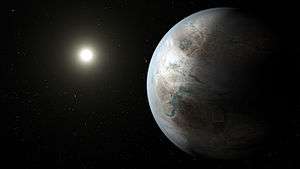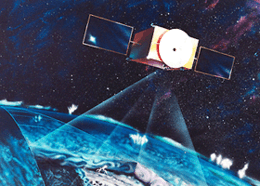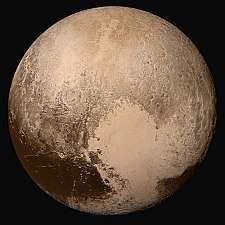(33342) 1998 WT24
 Tracks of asteroid 1998 WT24 | |
| Discovery [1] | |
|---|---|
| Discovered by | LINEAR |
| Discovery site | Lincoln Lab's ETS |
| Discovery date | 25 November 1998 |
| Designations | |
| MPC designation | (33342) 1998 WT24 |
| 1998 WT24 | |
| Aten · NEO · PHA [1][2] | |
| Orbital characteristics [1] | |
| Epoch 28 June 2009 (JD 2455010.5) | |
| Uncertainty parameter 0 | |
| Observation arc | 18.98 yr (6,933 days) |
| Aphelion | 1.0187 AU |
| Perihelion | 0.4182 AU |
| 0.7185 AU | |
| Eccentricity | 0.4179 |
| 0.61 yr (222 days) | |
| 344.05° | |
| 1° 37m 6.24s / day | |
| Inclination | 7.3419° |
| 82.000° | |
| 167.30° | |
| Earth MOID | 0.0097 AU (3.8 LD) |
| Physical characteristics | |
Mean diameter |
0.35±0.04 km[3] 0.410 km (taken)[4] 0.415±0.040 km[5] |
|
3.6970±0.0002 h[5] 3.697±0.0006 h[6][lower-alpha 1] 3.697 h[7] 3.6977±0.0023 h[lower-alpha 2] 3.698 h[lower-alpha 3] 3.7±0.1 h[8] | |
|
0.34±0.2[5] 0.56±0.2[3] 0.75±0.35[9] | |
| E [9] · S [4] | |
| 17.9[1] · 18.5±0.3[3] · 18.69[4] · 18.69±0.3[5] | |
|
| |
(33342) 1998 WT24 is a bright, sub-kilometer asteroid, classified as near-Earth object and potentially hazardous asteroid (PHA) of the Aten group, located in Venus's zone of influence that has frequent close encounters with Mercury, Venus, and Earth.[1] It made a close approach to Earth on 11 December 2015, passing at a distance of about 4.2 million kilometers (2.6 million miles, 11 lunar distances)[10] and reaching about apparent magnitude 11.[11]
The asteroid was discovered on November 25, 1998, by LINEAR about four months after a close encounter with the planet Mercury (about 0.047 AU).[1] It measures approximately 400 meters in diameter. It is also one of the best studied PHAs and was the 10th Aten asteroid to be numbered.
Classification and orbit
_1998_WT24_bistatic_radar_image.gif)
1998 WT24 orbits the Sun at a distance of 0.42–1.02 AU once every 7 months (222 days; semi-major axis of 0.72 AU). Its orbit has an eccentricity of 0.42 and an inclination of 7° with respect to the ecliptic.[1]
Low aphelion
At the time of its discovery, astronomers were trying to find the first Apohele asteroid (one that is always closer to the Sun than Earth). All asteroids known at the time that got closer to the Sun than Earth also crossed Earth's orbit. Earlier that year, David J. Tholen claimed to have spotted the first Apohele asteroid, which was dubbed 1998 DK36. However, the object was lost without being confirmed. Thus, 1993 DA remained the asteroid with the lowest known aphelion at 1.023 AU. When 1998 WT24 was discovered, it was found to have a slightly smaller aphelion (1.019 AU) than 1993 DA, and was thus the closest thing to an Apohele asteroid known at the time. It lost its smallest aphelion title almost immediately when (415713) 1998 XX2 was discovered only a few weeks later (aphelion = 1.014 AU). Asteroids with even smaller aphelions were discovered until February 2003, when finally, an asteroid with an aphelion smaller than 1.000 AU was discovered. This was 163693 Atira, the first confirmed Apohele asteroid.
Venus zone of influence
1998 WT24 was the second asteroid discovered to be close enough to Venus as to be within the major planet's zone of influence. It is located at about the inner edge of the zone, while (99907) 1989 VA, the first asteroid discovered there, is at about the outer edge. It is possible for planets to capture asteroids located in their sphere of influences into co-orbital relationships such as Trojan and horseshoe asteroids. Because of its frequent close encounters with Mercury and Earth, however, it may prove difficult for Venus to keep 1998 WT24 in a co-orbital relationship for any length of time. Of the six objects in Venus's zone of influence, only one (2002 VE68) is currently a co-orbital.
Record close encounter
1998 WT24 is a potentially hazardous asteroid. That means its orbit takes it very close to Earth and if it were to collide with our planet, it would cause devastation on at least a regional scale. On December 16, 2001,[1] it became the first PHA to be observed passing within 5 Lunar Distances (the average distance between Earth and the Moon) from Earth. Other asteroids have come closer, and numerous have even come closer than the Moon, but these have all been small asteroids, incapable of causing much damage to the planet, or much concern. The 2001 encounter was the closest known approach to Earth any PHA had made since (192642) 1999 RD32 passed by on August 27, 1969.[12] However, 1999 RD32 was not discovered until September 1999 many years after its closest approach, so no one knew about 1999 RD32 in 1969.
| Date | Distance from Earth |
|---|---|
| 1908-12-16 | 0.00907 AU (1,357,000 km; 843,000 mi) |
| 1956-12-16 | 0.009054 AU (1,354,500 km; 841,600 mi) |
| 2001-12-16 | 0.012485 AU (1,867,700 km; 1,160,600 mi) |
| 2099-12-18 | 0.012640 AU (1,890,900 km; 1,175,000 mi) |
In September 2004, the well known PHA 4179 Toutatis came about 4 Lunar Distances from Earth. Due to its diameter being over ten times larger (5.7 km) and its closer approach, Toutatis at its closest (mag 8.9) was about half an apparent magnitude brighter than 1998 WT24 was at its closest (mag 9.5).[12] However, Toutatis arrived during a full moon, and thus 1998 WT24's 2001 encounter is still the most easily observed flyby of an asteroid in history. It also made 1998 WT24 the first Near-Earth asteroid observed to be brighter than magnitude 10.
| PHA | Date | Approach distance in lunar distances | Abs. mag (H) |
Diameter (C) (m) |
Ref (D) | ||
|---|---|---|---|---|---|---|---|
| Nominal(B) | Minimum | Maximum | |||||
| (33342) 1998 WT24 | 1908-12-16 | 3.542 | 3.537 | 3.547 | 17.9 | 556–1795 | data |
| (458732) 2011 MD5 | 1918-09-17 | 0.911 | 0.909 | 0.913 | 17.9 | 556–1795 | data |
| (7482) 1994 PC1 | 1933-01-17 | 2.927 | 2.927 | 2.928 | 16.8 | 749–1357 | data |
| 69230 Hermes | 1937-10-30 | 1.926 | 1.926 | 1.927 | 17.5 | 668–2158 | data |
| 69230 Hermes | 1942-04-26 | 1.651 | 1.651 | 1.651 | 17.5 | 668–2158 | data |
| (137108) 1999 AN10 | 1946-08-07 | 2.432 | 2.429 | 2.435 | 17.9 | 556–1795 | data |
| (33342) 1998 WT24 | 1956-12-16 | 3.523 | 3.523 | 3.523 | 17.9 | 556–1795 | data |
| (163243) 2002 FB3 | 1961-04-12 | 4.903 | 4.900 | 4.906 | 16.4 | 1669–1695 | data |
| (192642) 1999 RD32 | 1969-08-27 | 3.627 | 3.625 | 3.630 | 16.3 | 1161–3750 | data |
| (143651) 2003 QO104 | 1981-05-18 | 2.761 | 2.760 | 2.761 | 16.0 | 1333–4306 | data |
| 2017 CH1 | 1992-06-05 | 4.691 | 3.391 | 6.037 | 17.9 | 556–1795 | data |
| (170086) 2002 XR14 | 1995-06-24 | 4.259 | 4.259 | 4.260 | 18.0 | 531–1714 | data |
| (33342) 1998 WT24 | 2001-12-16 | 4.859 | 4.859 | 4.859 | 17.9 | 556–1795 | data |
| 4179 Toutatis | 2004-09-29 | 4.031 | 4.031 | 4.031 | 15.30 | 2440–2450 | data |
| 2014 JO25 | 2017-04-19 | 4.573 | 4.573 | 4.573 | 17.8 | 582–1879 | data |
| (137108) 1999 AN10 | 2027-08-07 | 1.014 | 1.010 | 1.019 | 17.9 | 556–1795 | data |
| (35396) 1997 XF11 | 2028-10-26 | 2.417 | 2.417 | 2.418 | 16.9 | 881–2845 | data |
| (154276) 2002 SY50 | 2071-10-30 | 3.415 | 3.412 | 3.418 | 17.6 | 714–1406 | data |
| (164121) 2003 YT1 | 2073-04-29 | 4.409 | 4.409 | 4.409 | 16.2 | 1167–2267 | data |
| (385343) 2002 LV | 2076-08-04 | 4.184 | 4.183 | 4.185 | 16.6 | 1011–3266 | data |
| (52768) 1998 OR2 | 2079-04-16 | 4.611 | 4.611 | 4.612 | 15.8 | 1462–4721 | data |
| (33342) 1998 WT24 | 2099-12-18 | 4.919 | 4.919 | 4.919 | 17.9 | 556–1795 | data |
| (85182) 1991 AQ | 2130-01-27 | 4.140 | 4.139 | 4.141 | 17.1 | 1100 | data |
| 314082 Dryope | 2186-07-16 | 3.709 | 2.996 | 4.786 | 17.5 | 668–2158 | data |
| (137126) 1999 CF9 | 2192-08-21 | 4.970 | 4.967 | 4.973 | 18.0 | 531–1714 | data |
| (290772) 2005 VC | 2198-05-05 | 1.951 | 1.791 | 2.134 | 17.6 | 638–2061 | data |
| (A) This list includes near-Earth approaches of less than 5 lunar distances (LD) of objects with H brighter than 18. (B) Nominal geocentric distance from the center of Earth to the center of the object (Earth has a radius of approximately 6,400 km). (C) Diameter: estimated, theoretical mean-diameter based on H and albedo range between X and Y. (D) Reference: data source from the JPL SBDB, with AU converted into LD (1 AU≈390 LD) (E) Color codes: unobserved at close approach observed during close approach upcoming approaches | |||||||
Frequent inner-planet encounters
1998 WT24 is a Mercury-crosser asteroid, a Venus-crosser asteroid, and an Earth-crosser asteroid. Because of its relatively low inclination (7.34°), it is able to come close to each of these planets. Its orbit takes it within 0.021 AU of Mercury's orbit, 0.0368 AU of Venus's orbit, and 0.00989 AU of Earth's orbit. It makes frequent encounters with these inner planets. The last time it came close to Mercury, Venus and Earth was 2010, 1977, and November 12, 2004 respectively.[1] The most recent close approach to Earth was on 11 December 2015 at about 4.2 million kilometers (2.6 million miles, 11 lunar distances). The next visit of the asteroid to Earth's neighborhood will be on 11 November 2018, when it will make a relatively distant pass at about 20 million kilometers (12.5 million miles, 52 lunar distances).[10] These encounters perturb its orbit parameters slightly, and each pass reduces its inclination further.
Physical characteristics
During its close encounters in 2001 and 2015, astronomers were able to make radar images of its surface and determine physical properties that remain unknown for most asteroids.[10] According to the ExploreNEOs Warm Spitzer Exploration Science program, 1998 WT24 is a bright E-type asteroid with an exceptionally high albedo of 0.75±0.35.[9]
Diameter and albedo
1998 WT24 measures between 350 and 415 meters in diameter and its surface has an albedo between 0.34 and 0.75.[3][5][9][lower-alpha 3] The Collaborative Asteroid Lightcurve Link an albedo of 0.34 and takes a diameter of 410 meters based on an absolute magnitude of 18.69.[4] The asteroid is modestly elongated, approximately 420 × 330 meters.
Rotation period
Several rotational lightcurves of 1998 WT24 have been obtained from radiometric and photometric observations.[5][6][7][8][lower-alpha 2][lower-alpha 3] Lightcurve analysis gave a consolidated rotation period of 3.697 hours with a brightness amplitude between 0.19 and 0.65 magnitude (U=3).[4][lower-alpha 1]
Future flyby candidate
1998 WT24 has an orbit that not only crosses Earth's orbit, but is roughly parallel to it at its furthest. This means that during favourable years it is easy to reach from Earth. Several times this decade, it will be an easier target than Earth's own Moon. It is high on the list of possible Near-Earth Asteroid targets for future flybys, landings, mining, or orbit manipulations.
Numbering and naming
This minor planet was numbered by the Minor Planet Center on 28 January 2002.[13] As of 2018, it has not been named.[2]
See also
Notes
- 1 2 Several lightcurve plots of (33342) obtained at the Center for Solar System Studies by B. D. Warner (2015).
- 1 2 Pravec (2001) web. Observations from December 2001. Rotation period 3.6977±0.0023 hours with a brightness amplitude of 0.28 mag. Quality Code of 3. Summary figures for (33342) at the LCDB and Pravec, P.; Wolf, M.; Sarounova, L. (2001), see Ondrejov data obtained by the NEO Photometric Program and collaborating projects
- 1 2 3 Robinson (2011) web: rotation period 3.698 hours with a brightness amplitude of 0.26 mag. Quality Code of 3. Summary figures for (33342) at the LCDB
References
- 1 2 3 4 5 6 7 8 9 10 "JPL Small-Body Database Browser: 33342 (1998 WT24)" (2017-11-17 last obs.). Jet Propulsion Laboratory. Retrieved 30 January 2018.
- 1 2 "(33342) 1998 WT24". Minor Planet Center. Retrieved 30 January 2018.
- 1 2 3 4 Harris, Alan W.; Mueller, Michael; Delbó, Marco; Bus, Schelte J. (June 2007). "Physical characterization of the potentially hazardous high-albedo Asteroid (33342) 1998 WT 24 from thermal-infrared observations". Icarus. 188 (2): 414–424. Bibcode:2007Icar..188..414H. doi:10.1016/j.icarus.2006.12.003. Retrieved 30 January 2018.
- 1 2 3 4 5 "LCDB Data for (33342)". Asteroid Lightcurve Database (LCDB). Retrieved 30 January 2018.
- 1 2 3 4 5 6 Busch, Michael W.; Benner, Lance A. M.; Ostro, Steven J.; Giorgini, Jon D.; Jurgens, Raymond F.; Rose, Randy; et al. (June 2008). "Physical properties of near-Earth Asteroid (33342) 1998 WT24 [ Erratum: 2008Icar..197..375B ]". Icarus. 195 (2): 614–621. Bibcode:2008Icar..195..614B. doi:10.1016/j.icarus.2008.01.020. Retrieved 30 January 2018.
- 1 2 Warner, Brian D. (April 2016). "Near-Earth Asteroid Lightcurve Analysis at CS3-Palmer Divide Station: 2015 October-December". The Minor Planet Bulletin. 43 (2): 143–154. Bibcode:2016MPBu...43..143W. ISSN 1052-8091. Retrieved 30 January 2018.
- 1 2 Krugly, Yu. N.; Belskaya, I. N.; Chiorny, V. G.; Shevchenko, V. G.; Gaftonyuk, N. M. (November 2002). "CCD photometry of near-Earth asteroids in 2001". In: Proceedings of Asteroids: 903–906. Bibcode:2002ESASP.500..903K. Retrieved 30 January 2018.
- 1 2 Behrend, Raoul. "Asteroids and comets rotation curves – (33342) 1998 WT24". Geneva Observatory. Retrieved 30 January 2018.
- 1 2 3 4 Thomas, C. A.; Trilling, D. E.; Emery, J. P.; Mueller, M.; Hora, J. L.; Benner, L. A. M.; et al. (September 2011). "ExploreNEOs. V. Average Albedo by Taxonomic Complex in the Near-Earth Asteroid Population". The Astronomical Journal. 142 (3): 12. Bibcode:2011AJ....142...85T. doi:10.1088/0004-6256/142/3/85. Retrieved 30 January 2018.
- 1 2 3 "Asteroid Looks Even Better Second Time Around". NASA JPL. 17 December 2015. Retrieved 18 December 2015.
- ↑ "(33342) 1998WT24 Ephemerides for December 2015". NEODyS-2 (Near Earth Objects - Dynamic Site). Retrieved 2015-10-14.
- 1 2 "Bright Asteroid". NASA Science. 2001-12-14. Archived from the original on 2014-03-02. Retrieved 2014-02-26.
- ↑ "MPC/MPO/MPS Archive". Minor Planet Center. Retrieved 24 February 2018.
External links
- IMAGES OF ASTEROID 1998 WT24 - NASA
- Physical properties of near-Earth Asteroid (33342) 1998 WT24 - shape model of 1998 WT24 from Goldstone and Arecibo radar imaging 2001
- Radar Investigations of Asteroid 33342 (1998 WT24) in December 2001 with Evpatoria-Medichina and Goldstone-Medichina Bistatic Systems
- (33342) 1998 WT24 at the JPL Small-Body Database


